Update, April 23, 2019: Doubly wrong! When I wrote this post earlier today, I was examining the very light “ink” with the words “in part” on a key manuscript by W.W. Phelps (“Notebook of Copied Characters, circa Early July 1835“) that equates three lines of Egyptian to four lines of English. I argued that based on the extremely light appearance, it seemed that Phelps has changed his mind and attempted to scrape off the ink, as has been done elsewhere in the Kirtland Egyptian Papers. However, Dan Vogel kindly dropped by to say that according to the book by Hauglid and Jensen, the “in part” is actually pencil. (That doesn’t appear to be stated in the source note and associated information for this document on the Joseph Smith papers website. Could someone provide the page number and an image of their statement in the book for clarity? I don’t have the physical book over here in China.) If so, that’s good to know — thank you, Dan — and was one of my initial guesses mentioned in my comments on my previous post.
Based on the appearance, yes, it could be pencil. It does show more nonuniformity, which I assumed was due to the scraping action on the textured paper, but can easily be due to pencil scraping over the paper instead. I suppose in good light one can see the difference clearly between pencil and partially removed ink. Is there certainty that it’s pencil? I assume so, but want to check. Other examples (here and here) I’ve seen with pencil and pen on the same document have the pencil with fairly uniform line widths and can seem a little clumsier than the inked text, so it’s still fair to check.
If Phelps added “in part” later in pencil, my comparison of ink densities and other erasures is moot — but the significance of this document is unchanged. This does not make the document irrelevant, but simply puts us back to my previous view that “in part” was a late addition, and the use of pencil instead of ink only increases the sense of distance between what Phelps was thinking as he penned his translation and whatever he was thinking when he added “in part.”
The fact that he wasn’t even using his pen and ink when he added that suggests it may have been hours, days, or even weeks after he wrote the Egyptian text and the English “translation.” Why did he choose to use a pencil at that later time? Most importantly, why did he want to add “in part”? Was it because he later added the drawings that accompany the text? Did his “pure language” aspirations later lead him to hope that one might extract more hidden meaning from the basic translation of the Egyptian?
While some voices will continue to chant the mantra that it’s obvious that Joseph thought he was translating the Book of Abraham from a few single characters, this requires a series of assumptions about what the scribes were thinking they were doing as they added characters to the margins of the already existing text they were copying. We have no statement from them that their work gives us any insight into the actual translation and actually flies in the face of the most direct information we have. When Phelps put ink to paper in July 1835 and wrote these pages, he clearly was indicating that three lines of Egyptian yielded four lines of English text. That’s valuable information. Later he seems to have added “in part” in pencil. Was there more Egyptian on the page now from added drawings? Was there more meaning to be eked out? Had he forgotten to write a final line of the translation? Whatever his meaning was, there’s no evidence here that he now felt that many pages of text could be created from a few characters. That position comes from forcing the assumption to override the plain meaning of what Phelps first wrote in permanent ink. The pencil doesn’t erase that proposition and compel us to believe that now he realized that only one character had been translated.
Now my original and partly moot, largely wrong post follows:
Update, April 30, 2019: Today I noticed there is another document from Oliver Cowdery mentioning Katumin and giving the same English text that Phelps provides. The document is listed as “‘Valuable Discovery,’ circa Early July 1835.” Interestingly, Cowdery places some of the same Egyptian characters in line with the English. His document, from a notebook signed on the cover by Joseph Smith, associates only 6 or 7 characters with the English text, which may explain what he means when speaking of the “comprehensive” nature of the Egyptian and may indicate that Phelps believed he had only provided part of the translation of the Egyptian after all. I may have been wrong in my analysis below, at least in part.
Cowdery, like Phelps in his notebook, spells the names without the added “h” after some vowels that would become more common after Joseph and his brethren began study Hebrew at the end of 1835 and especially in 1836 when Joshua Seixas came to Kirtland at Joseph’s request. These spelling clues may be one of the most important things about these documents, showing how spelling changes after Joseph and his brethren began zealously learning Hebrew from Joshua Seixas in early 1836, which has the surprising implication that the dates many people have assumed for the Kirtland Egyptian Papers are simply too early, and may need to be reclassified as 1836 works, thus coming after the translation of at least much of the Book of Abraham had been completed. Further research is needed on this issue. See the discussion on my following post from April 30, 2019, “Two Important, Even Troubling, Clues About Dating from W.W. Phelps’ Notebook with Egyptian ‘Translation’.”
My original post here follows. Take it with a grain of salt, though it may still apply to what Phelps initially thought.
Readers, please forgive me for my sloppy conclusions driven by my amateur apologetics orientation. It’s time to admit I’ve made a significant blunder in evaluating the W.W. Phelps document that I discussed in my previous post, “Notebook of Copied Characters, circa Early July 1835.” That document, which occurs in a bound notebook, provides three lines of Egyptian text and four lines of English text, and calls the English a translation of the Egyptian — as if Phelps understood that it might take around 40 or so Egyptian characters to equal 50 English words, not one character for a hundred or so words. However, I think I blundered when downplaying the emendation to the text. As a reminder, here’s the image of the English text from Phelps, complete with the emendation:
Here is a closeup of “in part”:
When looking at this manuscript and the beginning of the Book of Abraham Manuscript C, shown below, where the very dark verses 1-3 are in Phelps’ handwriting followed by much lighter writing by Warren Parrish, it seems that Phelps liked writing with strong ink. So why is “in part” so light?
Here’s the Egyptian text that Phelps wrote on the next page of this notebook, also showing his penchant for writing in dark ink:
For his English comments, here is the transcript of page 1 as provided by the Joseph Smith Papers website for their Volume 4 on the Book of Abraham, as presumably edited by Brian Hauglid and Robin Jensen:
A Translation of the next page <in part>
Katumin, Princess, daughter of On=i=tas <King> of Egypt, who reigned began to reign in the year of the world, 2962.
Katumin was born in the 30th year of the reign of her father, and died when <s>he was 28 years old, which was <the year> 3020
Unfortunately, I think this is wrong. I’ll show in a moment why I think a more accurate transcript would read as follows, with my changes highlighted in yellow:
A Translation of the next page in part
Katumin, Princess, daughter of On=i=tas <King> of Egypt, who reigned began to reign in the year of the world, 2962.
Katumin was born in the 30th year of the reign of her father, and died when <s>he was 28th years old, which was <the year>
3020
I realized this once I learned that scribal errors in the Kirtland Egyptian Papers were sometimes corrected by scraping off the ink and rewriting. Dan Vogel, for example, calls attention to the correction made by scraping off ink and repositioning a couple of Egyptian characters in the margins of the page 7 of Manuscript C in the handwriting of Warren Parrish. He makes a fair point that this shows attention to detail in aligning these characters with the text. What’s interesting is that you can still see the ink after it has been scraped, but now it is much lighter:
Given that Parrish’s writing was not as black as Phelps’, it makes sense that an attempt to scrape away ink would leave a heavier stain in Phelps’ case. We can see a correction in action in his English “translation” of Egyptian on page 1 of the notebook mentioned above. There’s an obvious grammar error when he begins to write “she was 28th years old.” It seems that he immediately realized that it should be 28, not 28th, and so, probably before he started “years,” he took his knife or whatever he used to scrape ink, and scraped away the heavy “th” that he had just written. The ink appears to have still been wet, for he smears it downward, and a little pool is still left at the bottom of the scraping path. The result of this obvious emendation is that the “th” is still plainly visible, but so much lighter that we should readily understand it represents text that has been deleted. This is why, when I provided a transcript of the English in my previous post on this letter, I did not write “28th.”
We can also see related corrections in his writing near the beginning of Manuscript C:
According to the transcript, Phelps wrote “desiring one <to be> one”. Instead of striking out the premature “one” and commencing after the strike out, it appears that “one” has been made lighter, presumably by scraping, allowing him to just write over it with “to be.”
Turning our attention back to Phelps’ emendation of “in part”, note that it has about the same darkness as this scraped “one” above and the scraped “th” from “28th,” though it lacks the smearing of the latter, probably because the ink was more dry when he changed his mind. When did that change occur? When I look at the backside of the notebook page in question, I can see ink that has gradually diffused into the paper for much of his writing (but probably not the scraped “th” of “28th”). This process, in my experience, takes a number of days with good paper. There is no sign of ink bleeding through from “in part,” which to me suggests it happened fairly soon after being written, but not immediately as in the “28th” error.
In any case, I believe the best way to treat “in part” as an emendation is to recognize that it is a deletion, consistent with other scraped deletions he has made, not an insertion in what might be unusually light ink for Phelps. [Correction, April 23, 2019: I have since learned that the very light “in part” may actually be pencil, which would indicate that it was in fact added some time — days? weeks? — after Phelps penned his original statement. See my update at the top of this post for discussion of the implications. The Phelps document remains critically important.]
Why did Phelps change his mind? Perhaps he was going to write more Egyptian on the next page, and instead just stuck with what he thought he or someone else had translated. Perhaps he was going to write less English, but decided to show the whole text. I’m not sure, but I think it’s fair to read this as a deletion of “in part,” not an addition.
For confirmation, I think we should do some microscopic analysis. There are some light spots that show up in the scraped “in part” as if the high parts of the paper are being scraped more effectively than the low spots. More scientific analysis of the document could surely confirm the nature of the “in part” text, but for now, I feel the best hypothesis is that this emendation represents a deliberate deletion.
This may be a disappointment to those who insist that “everyone knows” that Phelps and Joseph Smith thought a single character could represent hundreds of English words. But remember, Joseph Smith or a scribe (probably with his approval, of course) spoke of “characters” in the plural representing a name in the comments on Facs. 3. And when Joseph saw the four Egyptian figures that we now know are the sons of Horus on Facsimile 2, he did not say that these characters represented a huge chunk of text, but said that they were “the four quarters of the earth,” which is one of the interesting bulls-eyes in the comments on the Facsimiles. The explanations of the figures and characters on the Facsimiles are short and sweet, not pages of text. And when Phelps discusses actual translation of Egyptian, he equates 40-something characters to around 50-words of English. Still compact, comprehensive, impressive, but not bizarre.
Many thanks to a kind anonymous reader whose comments called me out for underplaying the “in part” that W.W. Phelps had written. I hope you’ll understand that my mistake was understandable, for his “in part” was so light, it was easy to miss and really looked like it was written long after he had penned his original statement in bold, dark ink. So naturally but wrongly, I made too much of the difference in inks and argued that there must have been a long delay after writing the translation of the Egyptian text before he began thinking that maybe there was more to translate. But it was probably the same ink after all.
So again, my apologies for being absolutely wrong about the emendation by Phelps. “In part” did not come later, as I thought, but most likely was written in the same sitting as the rest of that page in his notebook, and indicates that his four lines of English do, apparently in full, represent the three lines of Egyptian characters that followed. While he may have thought there would be more Egyptian on the following page, or less English that he could share, he appears to have changed his mind. And so, a bit embarrassed but hoping for your forgiveness, I admit I was wrong once again.
Update, April 23, 2019: In my comments about Joseph Smith’s views on the translation of Egyptian, I’ve drawn upon some posts from Val Sederholm’s blog, I Begin to Reflect:
1. “What did Joseph Smith say about the nature of Egyptian hieroglyphs?,” May 17, 2017. This essay makes two important points. (1) The editors of the Joseph Smith Papers are seriously wrong when they say Joseph thought Egyptian was a primal language that could give vast meaning in a single character and when they say that Champollion‘s “ideas about the nature of Egyptian were not well known in the United States until “decades after his death in 1832,” and (2) Joseph’s own translation of the Book of Mormon from reformed Egyptian reveals that it was or at least included a phonetic system. Moroni 9:32, for example, tells us that “We have written this record according to our knowledge, in the characters which are called among us the reformed Egyptian, being handed down and altered by us, according to our manner of speech.” In other words, the characters could convey the sounds they spoke. “What a clear statement to the world, in March 1830(!), that Egyptian hieroglyphs reflect the ‘manner of speech.’ They are a) phonetic in make-up and thus b) can be altered to reflect phonological change.” Even if Joseph had remained unaware of the abundant news and talk of Champollion that had begin before he was born, there’s no room for assuming that he believed the Book of Mormon characters could magically convey long paragraphs from a single character. Sederholm goes on to consider other clues from Joseph’s comments about the Facsimiles and about the Book of Mormon to make it clear that he did not see Egyptian as a mystical emblem which yielded volumes of text to the mystic. Rather, like the scribal language that one generation taught the next among some of the Nephites, it was a system for reading and writing that could be learned by ordinary humans.
2. “Running from the Truth about Joseph Smith, the Book of Abraham Translation, and Little Red Riding Hood,” Jan. 25, 2017. Here Sederholm connects more dots from the Book of Mormon, which cannot be ignored if we are to understand what Joseph thought he was doing when he translated ancient characters, especially “reformed Egyptian”:
Now note how the Prophet Joseph Smith describes the title page of the Book of Mormon. When speaking of the particular gold plate that made up Moroni’s ancient title page, the Prophet correlates one plate to one page. And bear in mind that each plate was 6″ in width, 8″ in length, and that the English translation of the title page comprises a heading and two paragraphs. Again, here is no mystical, pre-decipherment “reading” of hieroglyphs as Symbol in which each sign contains of itself sufficient capacity to supply many sentences of esoterica or of Scripture.
No.
But the drumbeat continues: Joseph Smith held that a single Egyptian sign packs in a verbal outpour. That’s what everyone believed back then, we are told. He accordingly wrestles with each little character, for each unfolds vistas of narrative, vision, and doctrine.
That may describe Athanasius Kircher (it doesn’t); Joseph Smith can speak for himself. And his comments on the Book of Mormon title page date from 1838/1839, three to four years after he translated the first chapter of the Book of Abraham, and three years before he translated the rest! Brother Joseph, who compares the Egyptian writing on the last plate to “all Hebrew writing in general,” sees all hieroglyphs, formed or reformed or whatever, as a “running” script. That’s his word. “Running”: nothing could be more clear (Teachings of Presidents of the Church: Joseph Smith, 60-61; History of the Church 1:71-72 = “History of the Church,” Book A-1, 34-35.).
For Joseph Smith, then, should we follow his own crystalline descriptions of the nature of Egyptian writing, the 11 pages of unbroken narrative that make up the content of the published Book of Abraham would have been translated from several continuous, and presumably intact, sheets of papyrus (the translations tellingly show no gaps). Now, that’s not theory (“the missing roll theory“), that’s how Joseph Smith himself describes the nature of hieroglyphic text.
The fragmentary Book of Breathings thus has nothing to do with the making of the Abraham narrative.
3. “Is the book of Abraham ‘All Wrong’? Can the Critics be answered?,” June 15, 2018. Useful observations with some criticism of the weaknesses in the Church’s essay on the Book of Abraham, as well as criticism of Professor Ritner’s response.
This post is part of a recent series on the Book of Abraham, inspired by a frustrating presentation from the Maxwell Institute. Here are the related posts:
- “Friendly Fire from BYU: Opening Old Book of Abraham Wounds Without the First Aid,” March 14, 2019
- “My Uninspired “Translation” of the Missing Scroll/Script from the Hauglid-Jensen Presentation,” March 19, 2019
- “Do the Kirtland Egyptian Papers Prove the Book of Abraham Was Translated from a Handful of Characters? See for Yourself!,” April 7, 2019
- “Puzzling Content in the Egyptian Alphabet and Grammar,” April 14, 2019
- “The Smoking Gun for Joseph’s Translation of the Book of Abraham, or Copied Manuscripts from an Existing Translation?,” April 14, 2019
- “My Hypothesis Overturned: What Typos May Tell Us About the Book of Abraham,” April 16, 2019
- “The Pure Language Project,” April 18, 2019
- “Did Joseph’s Scribes Think He Translated Paragraphs of Text from a Single Egyptian Character? A View from W.W. Phelps,” April 20, 2019
- “Wrong Again, In Part! How I Misunderstood the Plainly Visible Evidence on the W.W. Phelps Letter with Egyptian ‘Translation’,” April 22, 2019
- “Joseph Smith and Champollion: Could He Have Known of the Phonetic Nature of Egyptian Before He Began Translating the Book of Abraham?,” April 27, 2019
- “Digging into the Phelps ‘Translation’ of Egyptian: Textual Evidence That Phelps Recognized That Three Lines of Egyptian Yielded About Four Lines of English,” April 29, 2019
- “Two Important, Even Troubling, Clues About Dating from W.W. Phelps’ Notebook with Egyptian “Translation”,” April 29, 2019
- “Moses Stuart or Joshua Seixas? Exploring the Influence of Hebrew Study on the Grammar and Alphabet of the Egyptian Language,” May 9, 2019
- “Egyptomania and Ohio: Thoughts on a Lecture from Terryl Givens and a Questionable Statement in the Joseph Smith Papers, Vol. 4,” May 13, 2019
- “More on the Impact of Hebrew Study on the Kirtland Egyptian Papers: Hurwitz and Some Curiosities in the GAEL,” May 20, 2019
- “He Whose Name Cannot Be Spoken: Hugh Nibley,” May 27, 2019
- “More Connections Between the Kirtland Egyptian Papers and Prior Documents,” May 31, 2019
- “Update on Inspiration for W.W. Phelps’ Use of an Archaic Hebrew Letter Beth for #2 in the Egyptian Counting Document,” June 16, 2019
- “The New Hauglid and Jensen Podcast from the Maxwell Institute: A Window into the Personal Views of the Editors of the JSP Volume on the Book of Abraham,” July 1, 2019
- “The Twin Book of Abraham Manuscripts: Do They Reflect Live Translation Produced by Joseph Smith, or Were They Copied From an Existing Document?,” July 4, 2019
- “Kirtland’s Rosetta Stone? The Importance of Word Order in the ‘Egyptian’ of the Grammar and Alphabet of the Egyptian Language,” July 18, 2019
- “The Twin BOA Manuscripts: A Window into Creation of the Grammar and Alphabet of the Egyptian Language?,” July 21, 2019
- “A Few Reasons Why Hugh Nibley Is Still Relevant for Book of Abraham Scholarship,” July 25, 2019

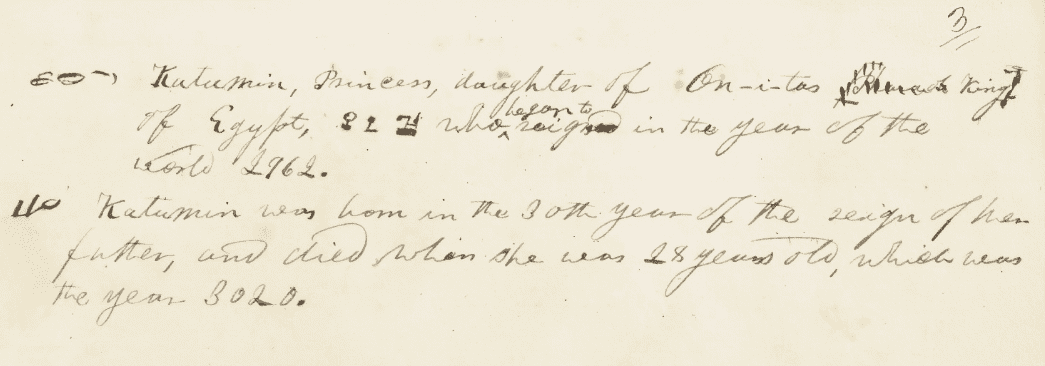

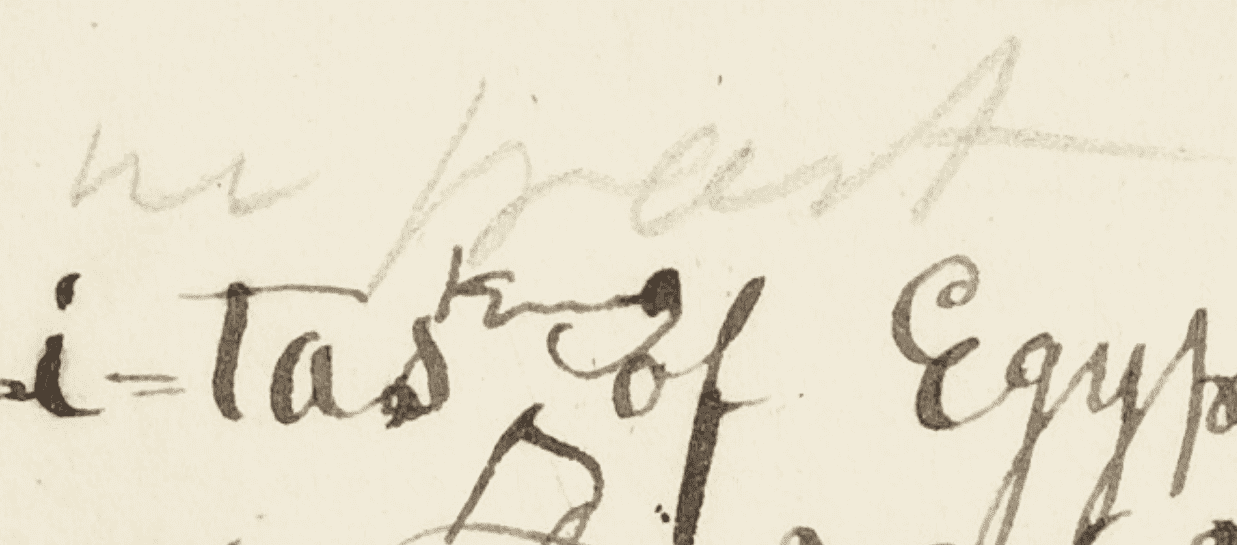
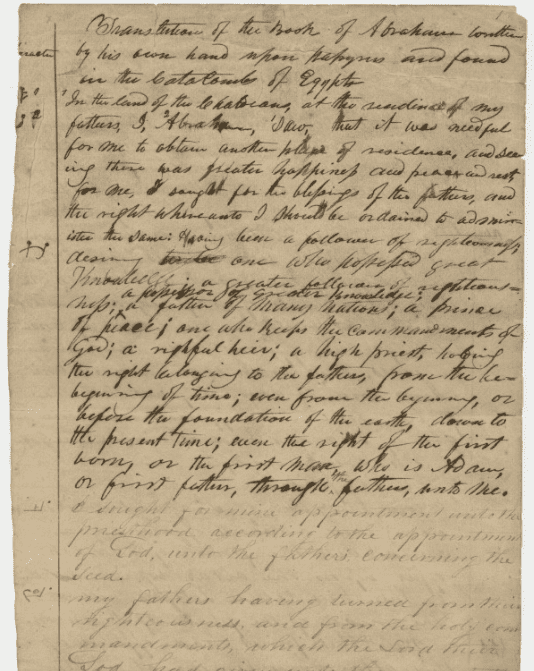

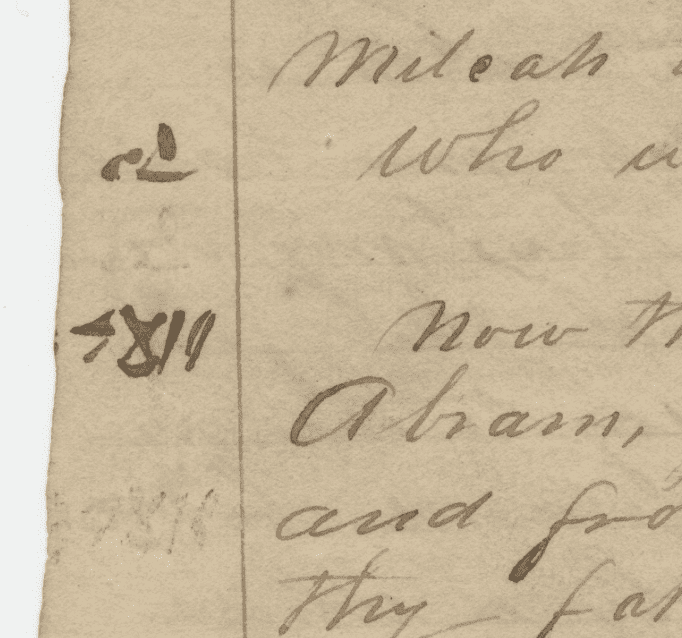
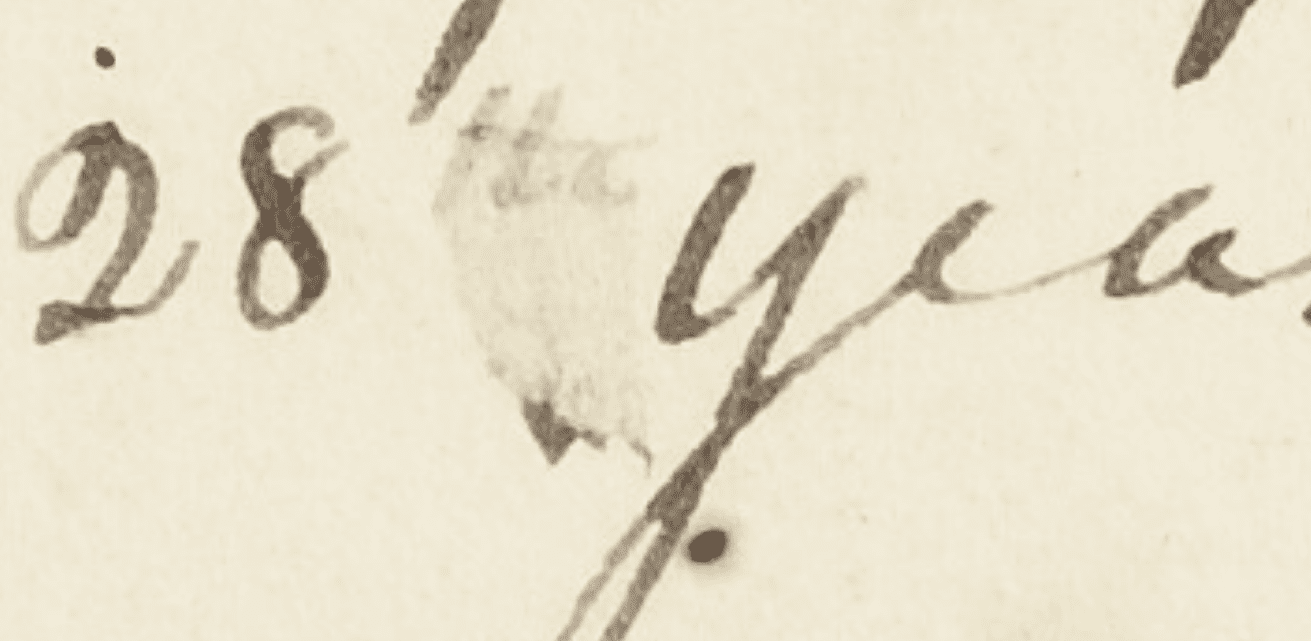
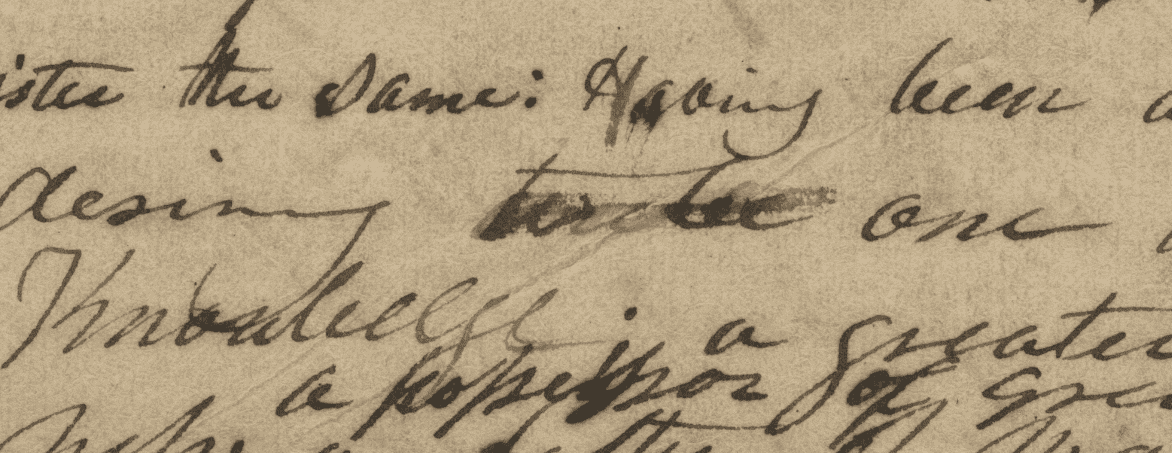


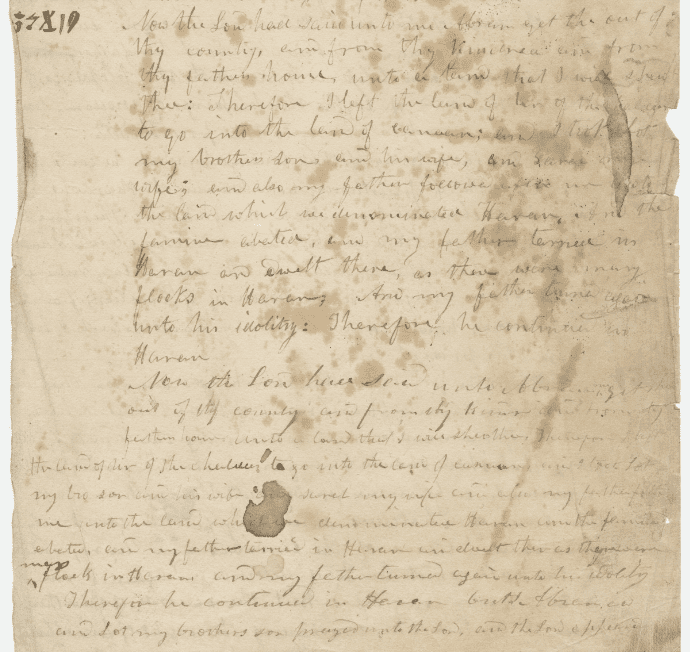








"in part" is in pencil or graphite, as indicated in Hauglid and Jenson's book.
In other news, the Book of Abraham is not an ancient text.
Someday Jeff will see what is so obvious to the rest of the world.
— OK
"what is so obvious to the rest of the world."
What is so obvious to the rest of the world, is that God just wants us to get the egg open, God does not care whether we open the egg from the little end or the big end. The Mormon artificially manufactured stress is that it matters to God which end of the egg we open, then confusing the success of getting the egg open for how the egg was opened or who taught us to open it. Marketing can slap labels like organic or locally grow, etc all they want on an omelet, but blind taste tests cannot tell the difference. The Mormon fraud is that it matters who the chef is, the God is no respecter of persons Mormon contradiction. For Jeff a rose by any other name does not smell the same, and hence he will never be able to pass a smell test and what is so obvious to the rest of the world, for example mingling Joseph Smiths's philosophies under the pseudonym of real or pretend authors of scripture does not make them smell different. Whether Chef Ramsay (or should we say Ramses in this case) or Joseph Smith, the omelet is still an omelet. Don't cry if a few eggs were broken or over who broke them, because the truth is Jeff, and it is obvious to the rest of the world, your Mormon omelet is no better than anyone else's.
How do you explain then the notebooks that have a single hieroglyph and then paragraph's of text?
If you look at the first page of the GAEL, it explains exactly how it works. There are five different layers of meaning for each character.
Hmm, the point of the details raised here is that one of Joseph's scribes, at least very near the time of Joseph's translation work, saw nothing shocking in having about 40 Egyptian characters equate to about 50 English words. This is a case of a reasonable argument, IMHO, being made from a reasonable reading of a primary source that greatly undermines the assumptions behind some of the "so obvious" views you are repeating here. Saying "you're so blind" and "it's so obvious" does not actually respond to the issues in a meaningful way, IMHO.
I always hope for actual responses and engagement on the issues being discussed, rather than the easy response of just claiming victory because "it so obvious." Kind of like those arguments I used to have in grade school where the key to victory was adding the proper intonation and confidence to the word, "Duh!" I usually lost those arguments in the eyes of my adversaries, as I've clearly lost here. But there's actually quite a lot of interesting territory that "it's so obvious" fails to cover.
This reasonable view that Phelps equated 3 lines of Egyptian with 4 or so of English is consistent with the way Joseph spoke of "reformed Egyptian" on the gold plates, where a plate, not just a stroke or two, corresponded to our title page, and in which Moroni 9:32 described as a system that conveys their spoken language (phonetic), and which Joseph called a "running" language that runs like Hebrew, etc. All this makes it clear that he did not see it as a bizarre system of emblems that could magically yield huge treasures of text.
Some critics want us to believe that the Kirtland Egyptian Papers show us Joseph's translation in progress, even though it's clear that the BOA manuscripts with the characters on the left had English being copied from an existing translation, not being created from a translation in progress. And even though the KEP contain characters that Phelp was toying with in his "pure language" musings before Joseph ever saw the papyri, along with many characters that are clearly not Egyptian. There are numerous assumptions wrapped into the arguments being used, but clarity from the Phelps document and from Joseph's various statements reveals that the "so obvious" views being chanted with great confidence and authority, like a mighty "duh" in perfect harmony, is a surprisingly inadequate reason to declare victory.
Brian G asked, "How do you explain then the notebooks that have a single hieroglyph and then paragraph's of text?"
If they came after the translation or were derived from the translation, why are they relevant? If they Kirtland Egyptian Papers from Phelps and other scribes contain many characters that are not Egyptian, such as the six "pure language" characters that Phelps was playing with before the scrolls were ever seen by Joseph, or the various Sanskrit, Arabic, and Masonic characters or ciphers, is it reasonable to maintain that this was a serious effort to crack Egyptian and translate the scrolls? If neither Joseph nor Phelps thought that a single character could produce over 100 words of English, then what is the basis for thinking that they were actually "translating" over 100 words from lone characters?
Something strange was going on, we all can see that, and some specific correlation was believed or hypothesized to exist between those characters and the existing translation. William Schryver makes a reasonable case for a reverse cipher system, but, like everything else with the KEP project, nothing came of the KEP work and whatever they were doing was soon abandoned. Building on Phelps' pure language fascination and trying to find characters that relate to themes or concepts in some parts of the text might have been going on, but it wasn't a translation. I don't think the theory of just decorating the text works. It's a mystery in need of more data, but not one that requires us to ignore and overrule the primary evidence from Phelps Joseph Smith, and the common knowledge of languages, including common knowledge sweeping Ohio at the time about the nature of Egyptian, though the details of Champollion's work would not be widely published and digested until later.
Unfortunately, Terryl Givens recently gave a lecture on translation where he showed that he thought very old ideas from Athanasius Kircher were part of "Egyptomania" in Joseph's day, leading people to think that one character could be equal a great deal of text. That doesn't fit what we see from Joseph's work and statements, or from the Phelps' document, or from the common knowledge of people in 1835. I fear we are going to hear that again in his upcoming book on the Pearl of Great Price, along with Hauglid's hypothesis taken from many before him that the KEP shows how the translation was done, when it really does not.
Look at the manuscripts and their details. It's clear that they represent copying of an existing translation, not a translation in progress. See my posts from the past couple of days for some details that you can check yourself.
So many books were written about which end to open egg it could fill libraries. Clearly, duh doesn't win the argument, especially if you start by assuming it matters which end to open. After all if there are libraries on the subject it must matter.
"where a plate, not just a stroke or two, corresponded to our title page"
Please note the difference between a plate, and a character, or characters. From the quote presented, Joseph isn't equating symbols to English, he is equating a page to a page. We aren't told what he thought he saw printed on the plate.
Along similar lines, have apologists ever addressed why there is a 17th/18th century style cover page present in a document supposedly written centuries earlier?
You mean the title page placed at the end of plates, following the ancient practice of subscriptio? See "Why is “Words of Mormon” at the End of the Small Plates?" Excerpt:
[T]he Title Page of the Book of Mormon was, according Joseph Smith, “a literal translation taken from the last leaf of the plates.”2 This is consistent with a common ancient practice known as subscriptio, where introductory information, such as “the indication of the name of the writer/author and the title of the book” is placed “right at the end, after the last line of the text.”3 Walter Burkert, an expert in the Classics, believed that the attestation of this practice in Greek literature was “a detailed and exclusive correspondence which proves that Greek literary practice is ultimately dependent upon Mesopotamia.”4
Give Jeff credit for sticking with the side he randomly drew at the start of debate class.
The Title Page issue deserves more attention. Joseph said the Title Page was “a literal translation taken from the last leaf of the plates.” On the Joseph Smith Papers website, you can see that quote in the following paragraph:
I would mention here also in order to correct a misunderstanding, which has gone abroad concerning the title page of the Book of Mormon, that it is not a composition of mine or of any other man’s who has lived or does live in this generation, but that it is a literal translation taken from the last leaf of the plates, on the left hand side of the collection of plates, the language running same as all Hebrew writing in general.
He saw reformed Egyptian as a language "running" like written Hebrew in general. He spoke of the translation of the title page as a "literal" one, not a mystic decoding of vast layers of symbolism from a stroke or two. The Title Page was obviously more than a squiggle or couple of characters, was a literal translation from the running language of reformed Egyptian taken from the last leaf on the gold plates. It may have been more compact than Hebrew, but it is a running language like Hebrew that can be literally translated. And as we know from Moroni 9:32, it can represent the spoken language of the people, making it have phonetic properties. What Joseph and the Book of Mormon tells us about reformed Egyptian is a vital starting place for understanding what Joseph was doing.
The critics who want to tell us that Joseph translated the Book of Abraham from a few characters on the existing papyri require us to believe that Joseph forget what he had experienced with reformed Egyptian script, and also overlook what W.W. Phelps showed about his views on the nature of Egyptian in his letter, in favor of a theory based on assumptions about what the scribes thought they were doing in unexplained work with characters in the margins of already translated text. I think the assumptions in their arguments need to be reconsidered.
“The Title Page issue deserves more attention.”
Agreed. Thanks for bringing up subscriptio—that was an interesting rabbit hole to dive down. It wasn’t so easy to research because Google likes to be too helpful and provide you lots of things to subscribe to, but it led me to an interesting unrelated article about Humanistic views of the Adamic language at its relation to Egyptian hieroglyphics. I look forward to exploring this subject a little further (see section II “Searching for the “Perfect Language” subsection A “The Adamic Language”). https://www.academia.edu/4383351/The_Voice_of_the_Picture_The_Functional_Relationship_Between_Text_and_Image_in_Geffrey_Whitney_s_A_Choice_of_Emblemes_1586_
Back to subscritio. Though examples weren’t easy to find, I think I came across some. I’ve also transcribed title pages from late 18th century works. I will display them below (3 examples of each in separate posts) and let your readers figure out which is which and of them, which examples are closer to the BoM title page in both style and content. But first, as a reminder, here is the BoM title page:
The Book of Mormon
An Account Written by the Hand of Mormon upon Plates Taken from the Plates of Nephi
Wherefore, it is an abridgment of the record of the people of Nephi, and also of the Lamanites—Written to the Lamanites, who are a remnant of the house of Israel; and also to Jew and Gentile—Written by way of commandment, and also by the spirit of prophecy and of revelation—Written and sealed up, and hid up unto the Lord, that they might not be destroyed—To come forth by the gift and power of God unto the interpretation thereof—Sealed by the hand of Moroni, and hid up unto the Lord, to come forth in due time by way of the Gentile—The interpretation thereof by the gift of God.
An abridgment taken from the Book of Ether also, which is a record of the people of Jared, who were scattered at the time the Lord confounded the language of the people, when they were building a tower to get to heaven—Which is to show unto the remnant of the house of Israel what great things the Lord hath done for their fathers; and that they may know the covenants of the Lord, that they are not cast off forever—And also to the convincing of the Jew and Gentile that Jesus is the Christ, the Eternal God, manifesting himself unto all nations—And now, if there are faults they are the mistakes of men; wherefore, condemn not the things of God, that ye may be found spotless at the judgment-seat of Christ.
BURKE, Edmund. An impartial history of the war in America.
An Impartial History of the War in America between Great Britain and her colonies from its commencement to the end of the year 1779. Exhibiting a circumstantial, connected, and complete account of the real Causes, Rise, and progress of the War, interpreted with anecdotes and characters of the different commanders, and accounts of such personages in Congress as have distinguished themselves during the contest. With an appendix containing a collection of interesting and authentic papers tending to elucidate history. Illustrated with a variety of beautiful copper-plates, representing real and animated likenesses of those celebrated generals who have distinguished themselves in the important contest.
A SHORT narrative of the horrid massacre in Boston … the fifth day of March, 1770.
Boston: Printed by order of the town; London: Re-printed for W. Bingley, 1770
A Short Narrative of the Horrid Massacre in Boston, perpetrated in the evening of the fifth day of March 1770. By soldiers of the XXIXth regiment which with the XIVth regiment were then quartered there: with some observations on the state of things prior to that catastrophe. To which is added , an appendix containing the several dispositions referred to in the preceding narrative; and also other depositions relative to the subject of it.
COLDEN, Cadwallader. The history of the five Indian nations of Canada.
London, 1750.
The History of the Five Indian Nations of Canada which are the barrier between the English and the French in that part of the world. With particular accounts of their religion manners, customs, laws, and government; their several battles and treatises with the European nations; their wars with the other Indians; and a true account of the present state of our trade with them. In which are shewn, the great advantage of their trade and alliance to the British nation; and the intrigues and attempts of the French to engage them from us; a subject nearly concerning all our American plantations and highly meriting the consideration of the British nation. By the Honourable Cadwallader Colden, Esq; on of His Majesty’s counsel, and surveyor-general of New York. To which are added, accounts of the several other nations of Indians in North America, their numbers strength, &c. and the treaties which have been lately made with them.
http://special.lib.gla.ac.uk/exhibns/Americana/18th_century.html
I, Germanos son ofJudas, have written (this).
Babeli the son of Menahem has written this.
(Aramaic) Yehudah son of Ktushion "lord of Babatha" in his presence testified Babatha according to the written above. Yehudah has written this.
(Nabatean) Abdobdat son of Illuta, in my presence and in the presence of my colleague Yohana the son of Egla, we wrote this testimony according to the above written. Abdobdat has written this.
(Aramaic) Yehohanan the son of Alex in the hand of Yehoseph his son. He who wrote this is Theenas son of Simon, librarius.
https://www.ideals.illinois.edu/bitstream/handle/2142/17276/illinoisclassica31978univ.pdf?sequence=1
I, Marcellus, a disciple of my Lord Peter, wrote what I saw.
https://books.google.com/books?id=qZnmCwAAQBAJ&pg=PA17&lpg=PA17&dq=wording+of+the+subscriptio+itself&source=bl&ots=PXNvmm1uCU&sig=ACfU3U2LKzmToNEHljtpNDvkV-PkGvKJbQ&hl=en&sa=X&ved=2ahUKEwjCpc6J7OfhAhVFo54KHX2VDd8Q6AEwE3oECAcQAQ#v=onepage&q=subscriptio&f=false
I, Tiberius Caesar Augustus, in the twenty second year of my tribunician power, wrote this with my own hand: it is my wish that this senatorial decree, which was passed on 10 December in the year when Cotta and Messala were consuls on the basis of my proposal and was copied by the hand of my quaestor Aulus on 14 tablets, should be placed in the public archives.
https://books.google.com/books?id=ZSjeAgAAQBAJ&pg=PA152&lpg=PA152&dq=wording+of+the+subscriptio+itself&source=bl&ots=CdfcBdGO6d&sig=ACfU3U0XnMLpxUV2iV-8xOp6wGrWM1vrHQ&hl=en&sa=X&ved=2ahUKEwjCpc6J7OfhAhVFo54KHX2VDd8Q6AEwFHoECAgQAQ#v=onepage&q=subscriptio&f=true
Also and interesting biblical subscriptio that I didn't include because it relates to the New Testament–not ancient enough.
by the holy apostle Paul, the Epistle to the Hebrews, written in Hebrew, from Italy anonymously through Timothy
Jeff – It is not clear what you are driving at. Is your claim that if eye witness testimony of even believers of the translation and remaining artifacts today indicate 20+ word in English for every one character of the source language, then faith in the "translation" can not be had? Is your contention that not only is there less than 20 English words, but 4-5, and therefore uncertainty allows for faith in the "translation" to continue for lack of further evidence?
The learned critics shock their audiences by alleging that the original documents show Joseph and his scribes thought he was translating one character or part of a character into many dozens of words. In making these claims, they obfuscate by failing to acknowledge the more reasonable views expressed by Joseph regarding reformed Egyptian and the more reasonable view expressed in Phelps letter. Why are those original and relevant documents and statements often not even mentioned and their obvious implications not openly addressed for others to weigh? When some of them claim that the pair of manuscripts from Williams and Parrish show Joseph dictating the original translation of a few characters, why do they not acknowledge the massive dittography and other issues which show the two scribes were merely copying already written text, and that the documents suggest Parrish was reading aloud for the benefit of Williams, until Parrish stopped and Williams started copying from sight rather than ear? Do these shortcuts and failures represent scholarship or polemics? That’s what I am driving at. People need to question the authority and scholarship of those with an axe to grind, just as they should check for themselves whatever I say.
Jeff you talk in circles, but rarely with any clarity. Pull your head out, sir.
Jeff – I see. Your point is to doubt doubts and the "the learned".
By insisting "People need to question the authority and scholarship of those with an axe to grind" AND " check for themselves whatever" you say, the level of effort becomes too great for the unlearned in a 24 hour day. They will never have enough evidence to invalidate faith. Therefore Joseph could possibly be a prophet according to the Mormon definition of prophet and if they are wrong, they can plead they were mislead before God. The good news is Joseph Smith is a prophet by the more generic, non-Mormon definitions of the word prophet. He just isn't a prophet by the Mormon definition of the word prophet. I agree, the simple minded will never understand this, but the deceitful, learned Mormons do.
Deceitful, learned Mormons with a axe to grind love to add smoke and mirrors. If the spirit is telling billions of humanity something different, then in the Mormon universe someone is either lying, delusional, or confused. Lying and delusional are opening consider secretly, however it is against the affect of the Mormon presentation technique, so that leaves only confused. Confused is also what billions say of the Mormons, just as the parables of Jesus are made up but the principles are true, so is Mormonism made up. Without a retort, the deceitful, learned Mormons need to come up with a bunch of red herrings to distract, strawmen attacks, and falsely accusing those that see the forest for the trees as big list attackers.
Here is the original title page, laid out more accurately. "Which is to shew" applies to both abridgments. "By the way of Gentile" and "if there be fault, it be the mistake of men" are examples of archaic usage, and the meaning of scatter is archaic. "How great things" is biblical. Non-restrictive personal which (2×) wasn't Joseph Smith's language.
The Book of Mormon
An account written by the hand of Mormon upon plates,
taken from the plates of Nephi.
Wherefore it is an abridgment of the record
of the people of Nephi, and also of the Lamanites,
written to the Lamanites,
which are a remnant of the house of Israel,
and also to Jew and Gentile,
written by way of commandment,
and also by the spirit of prophecy and of revelation,
written and sealed and hid up unto the Lord
that they might not be destroyed,
to come forth by the gift and power of God
unto the interpretation thereof,
sealed up by the hand of Moroni,
and hid up unto the Lord,
to come forth in due time by the way of Gentile,
the interpretation thereof by the gift of God.
An abridgment taken from the book of Ether also,
which is a record of the people of Jared,
which were scattered at the time
the Lord confounded the language of the people
when they were building a tower to get to heaven.
Which is to shew unto the remnant of the house of Israel
how great things the Lord hath done for their fathers,
and that they may know the covenants of the Lord,
that they are not cast off forever,
and also to the convincing of the Jew and Gentile
that Jesus is the Christ, the Eternal God,
manifesting himself unto all nations.
And now if there be fault, it be the mistake of men.
Wherefore condemn not the things of God,
that ye may be found spotless at the judgment seat of Christ.
"By the way of Gentile" and "if there be fault, it be the mistake of men" are examples of archaic usage, and the meaning of scatter is archaic. "How great things" is biblical. Non-restrictive personal which (2×) wasn't Joseph Smith's language.
It’s an attempt to sound ancient and biblical. Why would a translation use these elements otherwise? Why does a supposedly ancient document contain a translated title page that is similar in form and function to an 18th Century book?
You bring out an interesting neurosis of the BoM with the "if there be fault, it be the mistake of men.” The book seeks to excuse itself for mistakes from the beginning, and does so throughout. It also tries to convince its reader of its own veracity by repeating that the things said within it are true. Both are indications that the author is unsure how his text will be received—almost as if he fabricated it.
Why would a translation use these elements otherwise? Why does a supposedly ancient document contain a translated title page that is similar in form and function to an 18th Century book?
Because the Book of Mormon was translated into KJV English, as this is the scriptural language Joseph Smith and others were familiar with. Claiming that this is evidence of fraud or fabrication is ignoring the fundamental nature of how translation works.
Both are indications that the author is unsure how his text will be received—almost as if he fabricated it.
If the Book of Mormon was a fabrication, it seems extremely unlikely that Joseph Smith would have included a direct charge to its readers to find out its truthfulness for themselves.
“Claiming that this is evidence of fraud or fabrication is ignoring the fundamental nature of how translation works.“
I agree with this statement. I was pointing out to Mr. Titlepage that very fact—the choice of language is not proof of anything really. It’s a choice, as I said, to try to “sound ancient and biblical.” Finding an 18th century title page in a document that claims to be ancient, and in a title page that was supposedly translated from the ancient source document, is a little harder to explain.
As for your claim that it’s “extremely unlikely that Joseph Smith would have included a direct charge to its readers to find out its truthfulness for themselves,” I don’t agree. The confidence man’s greatest achievement is to inspire others to do his job for him. He also won’t have duped anyone if no one believes his story. Your statement is nonsensical on the face of it. Fraud requires belief.
Also, the request from Moroni isn’t to find out if it’s true, it’s to find out if it’s not true. A subtle difference, but once again the text insists to it’s reader that it is true.
“When ye shall receive these things” is said directly after talking about “how merciful the Lord” has been with mankind. Setting aside that mercy is entirely a matter of perspective, a human construct, and not something science really knows how to study, Moroni’s promise says the Holy Ghost will manifest truth of all things to people who are not defective (defective = those lacking sincerity and real intent), not all things that are not true, a much bigger list of things. For those non-defective souls who the Holy Ghost manifested the truth of “these things”, the LDS Church has already admitted that most of those few were utterly confused, for those souls mistakenly believed the Holy Ghost was manifesting to them that the Laminates were the principal ancestors of the Amerindians.
Joseph Smith did not include a charge to find out the truthfulness for themselves, just the opposite. He is encouraging them to just trust their emotions. Only a handful of existing fervent believers were allowed to “examine” the plates under unclear circumstances, before the plates disappeared for good. The list of oddities could go on. If you are going to play the if-fabrication-then-this game, you lose.
A title page found at the end of the translated text, coming from the last plate rather than the first, is one way in which the Book of Mormon's title page is a bit unusual relative to practices and common knowledge in the nineteenth century. As discussed above, it was a known practice in the ancient world.
Me: "I just heard gangsta rap recorded in 1776 on my favorite country station on the radio!"
Jeff: "It's unusual to hear rap on a country station, but music and poetry were quite common in 1776. This must mean it is what it claims to be."
I guess you're right. You win. . .
Jeff: A title page found at the end of the translated text, coming from the last plate rather than the first….
If ony we had those darned plates themselves, this might actually be a meaningful statement.
Anon 11:10: Well put.
— OK